Since the standard 9C style of hub construction should work well for heat-bridging the magnet-rim to side-plate...I believe this FF upgrade will prove to be very popular for the Leafbike-1500W and the MXUS-3000W...
You are using an out of date browser. It may not display this or other websites correctly.
You should upgrade or use an alternative browser.
You should upgrade or use an alternative browser.
Definitive Tests on the Heating and Cooling of Hub Motors
- Thread starter justin_le
- Start date
That's probably the best idea. I could use the one you sent, out of your early batches of the older ASI type, as it isn't on a bike yet (keep meaning to set it up on the trike for tests, but have been using the trike for transportation to/from work the last several months, and didn't wanna take it out of service if I break something doing it).justin_le said:You don't need to do any of that, just do what I've been doing on all of these runs. Use a field oriented motor controller that lets you inject field weakening current into the windings, and then you'll be able to heat up the insides exactly as if you were loading down the motor but without any of the mechanical complexity of putting an actual load on the hub. It truly works great and makes at-home thermal test experiments really feasible for anyone.
That I don't wanna do, as I'd potentially be making the motor unusable as a motor...even though I might be able to undo whatever I do to short the lams, I might not. :/Lacking a FOC, another way to increase the no-load heat generation inside a motor is to short together the steel laminations so that you have way higher eddie current losses in the core.
That's another one I might be able to undo...and might not.Perhaps an easier way to increase the no-load power draw is to just put a partial short circuit on one of the windings. If you scrape the enamel off the wires you can solder a bridge across some loops of copper on the core.
That'd be easier, but first I'd probably have to fix the halls in the motor, as it's likely most or all of the sensored ones I dont' presently have in use on CB2 or SBC have hall problems.If running a sensored controller, you can muck with the hall sensor timing to make it spin with extra heat. I haven't tried this but it could be as easy as putting capacitors on the hall signal lines to delay the transition timing.
Ah, but this isn't to see the stuff itself, but to watch over time as the motor does it's thing, to see if anything starts to happen to the FF or the motor or whatever, without having to take it off the stand, disassemble it and check it out.justin_le said:I hate to disappoint expectations but from my observations I think the results will be a lot less interesting than people here keep imagining from watching ferrofluid videos on youtube. From the side view there is nothing really to see, just some glistenings of oil in the very thin air gap.
Of course, most likely any issues with stuff would not be apparent from teh side, so it'd just as likely be an exercise in futility, but hey, if I were to try the project out anyway, and it wasn't too hard to do, I might as well do the side cover, too.
It'd be even more interesting if we had a transparent metal that was magnetic like the steel on the back of the magnets is, cuz then the ring/rotor could be made of that, and then the FF could be watched thru that, too. But unfortunatley transparency isn't generally a property of such metals.
made_in_the_alps_legacy
10 kW
We used to see the stator axle quite hot in the early stages of the experiments,
How much colder is it with FF, justin? (wondering if there is still a lot heat going that path...)
How much colder is it with FF, justin? (wondering if there is still a lot heat going that path...)
auraslip
10 MW
- Joined
- Mar 5, 2010
- Messages
- 3,535
Awesome to read ya'lls more educated responses on the abrasive topic.
I have another question. Would this be usable on golf cart motors? This could be another market. I don't think it'd be a good idea on brushed motors, but the RXV and IQ models use brushless motors. Heating can be a problem when loaded and traveling up hills. I could probably set up a crude test if we think it'll work.
I have another question. Would this be usable on golf cart motors? This could be another market. I don't think it'd be a good idea on brushed motors, but the RXV and IQ models use brushless motors. Heating can be a problem when loaded and traveling up hills. I could probably set up a crude test if we think it'll work.
auraslip said:I have another question. Would this be usable on golf cart motors? This could be another market. I don't think it'd be a good idea on brushed motors, but the RXV and IQ models use brushless motors. Heating can be a problem when loaded and traveling up hills. I could probably set up a crude test if we think it'll work.
Basically it should be quite useful on any sealed outrunner motor (like a hub motor, coils on the inside, magnets and rotor on the outside) which is exposed to external air flow. Direct Drive hub motors fit this bill perfectly and that's why we see such remarkable improvements with it. If the motor is an inrunner then it serves very little purpose, and if it's an outrunner motor in an enclosed vehicle chassis (so no external airflow) then it will be an improvement but the shell -> ambient heat path could become more limiting. Do you own one of these golf carts yourself?
justin_le said:As well, we've just finished potting the MXUS stator which had been modified with a plurality of thermistors separately located on the copper windings and in the stator backing.
View attachment 2
This is a silver potting compound because it has metallic aluminum filler as the thermal conductive element. Recall from the earlier tests on this hub that we had about a 6.5 degree temperature difference between the copper and the steel/aluminum when using the FF.
https://endless-sphere.com/forums/viewtopic.php?p=1112018#p1112018
Now we'll be able to directly assess how well the potted core keeps the copper and steel temperatures uniform. Although the steady state improvements might not be too substantial, 5 degrees or whatever, the transient benefits at really high power inputs could be more significant, since then the copper heat generation can be more directly and immediately absorbed by all the steel.
I've gotta say that these potted cores just look rugged and bad-ass, compared to the overall delicacy of seeing all the exposed copper strands, hall sensor wires, thermistors etc. In this case, there was enough of an oil film left on the stator laminations that it acted as a bit of a mold release and made it easy to scrape and shave the potting off the ends of the stator teeth, allowing us to be sure that there was no rubbing against the magnets or thin sections of epoxy flaking off:
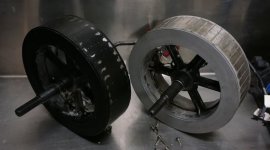
I ran this potted 4505 stator on the right with Statorade at 100, 200, 300, and 400 rpm measuring the core temperature in the 3 locations just as before. And the effect of potting with the highest thermal conductivity resin I could find (>3 W/mK) was that the overall temperature difference between the copper wire and the stator core decreased from ~ 6.5 degrees to ~ 3.5 degrees.

So from a purely thermal basis the potting of the core produces some small gains but nothing all that noteworthy. Just the stock winding configuration does a good enough job of transferring heat from the copper to the steel core that this isn't an area that needs special attention.
Great test.
Not too surprising that the potting doesn't make much difference since the copper is in direct contact with the iron.
A thin coat of epoxy or varnish may be all that is needed to keep the windings from moving around and help a little with heat transfer between wire strands.
If there was no FF in the gap, you might see more of a difference from stock, but not near as good as with the Statorade.
Not too surprising that the potting doesn't make much difference since the copper is in direct contact with the iron.
A thin coat of epoxy or varnish may be all that is needed to keep the windings from moving around and help a little with heat transfer between wire strands.
If there was no FF in the gap, you might see more of a difference from stock, but not near as good as with the Statorade.
Great work Justin!
for continuous power it is not worth potting the windings to the core. i agree with that.
if you ask me the advantages only will come into play at very high peaks. together with FF it would be optimal and the heat from the windings would be spread nearly over the total motor mass.
would like to see a test with VERY HIGH AMPS to see how it compares to a non potted core, but i believe this can be tested hard on the bench.
I really like the idea of your motor case with the lightweight back iron. the weight reduction is impressive. Thumbs up!
for continuous power it is not worth potting the windings to the core. i agree with that.
if you ask me the advantages only will come into play at very high peaks. together with FF it would be optimal and the heat from the windings would be spread nearly over the total motor mass.
would like to see a test with VERY HIGH AMPS to see how it compares to a non potted core, but i believe this can be tested hard on the bench.
I really like the idea of your motor case with the lightweight back iron. the weight reduction is impressive. Thumbs up!
johnrobholmes
10 MW
fechter said:Great test.
Not too surprising that the potting doesn't make much difference since the copper is in direct contact with the iron.
A thin coat of epoxy or varnish may be all that is needed to keep the windings from moving around and help a little with heat transfer between wire strands.
Based on my work with far smaller outrunner UAV motors, we haven't been able to test an appreciable change in the core temp with a fully potted stator VS a resin dipped stator.
VS bare wires, any method that fully wets through the coils will make a measurable improvement to motor quality. In regards to power it prevents burnout during peak loads by preventing hot spots. It eliminates coil vibration which increases long term reliability. What Justin has measured is more beneficial on larger motors IMO, it melds the thermal mass of the stator and coils together which improves burst power ability and heat transfer.
Now to root back through the thread for non potted mxus data to compare potted vs non potted copper temp. I would assume the delta T reduction of copper to core would also reflect as lower copper temp under a given load.
I also figured potting would not do much. The reason I figured this is because my cromotor takes about 800 watt hours of heat to become fully saturated with heat. Until it hits this point I can drive the motor as hard as I want and the temp probe in the windings doesn't go above 90c. If I hit a really steep hill and I full throttle the bike for 15 seconds almost stalled at 6000watts, the temp sometimes will jump to maybe 100c but in like 10-20 seconds fall right back down to 70c.
Once the stator gets fully heat saturated, the winding temp then shoots up very quickly and I can easily overheat the motor at that point and the temperature falls back down slowly.
Once the stator gets fully heat saturated, the winding temp then shoots up very quickly and I can easily overheat the motor at that point and the temperature falls back down slowly.
johnrobholmes
10 MW
Upon further consideration, the fully potted motor does give some advantage over just "dipped" if we consider long term reliability as the main goal. With the delicate parts sealed , an open sidecover is much more feasible too. With the core having some improved thermal coupling to the copper it can be more effective at shedding heat with airflow. The ability to mix open sidecover with ferrofluid is doubtful. I suspect road grit would quickly contaminate.
It's looking like easy and effective cooling methods will be between a wee bit of ferrofluid, or a potted/ sealed stator with open sidecovers. Exciting times 8)
It's looking like easy and effective cooling methods will be between a wee bit of ferrofluid, or a potted/ sealed stator with open sidecovers. Exciting times 8)
Kodin
1 kW
amberwolf said:It'd be even more interesting if we had a transparent metal that was magnetic like the steel on the back of the magnets is, cuz then the ring/rotor could be made of that, and then the FF could be watched thru that, too. But unfortunatley transparency isn't generally a property of such metals.
https://en.wikipedia.org/wiki/Aluminium_oxynitride
Justin, as I'd asked before, did you see any noticeable change in KV of the aluminum-based potted stator?
That's an interesting material I didn't know existed...but it appears to be a ceramic rather than a metal, and doesn't appear to have magnetic properties that could be used as the flux ring. 
But I wonder if it would work for side covers.
But I wonder if it would work for side covers.
macribs
10 MW
- Joined
- Jul 22, 2014
- Messages
- 3,702
amberwolf said:That's an interesting material I didn't know existed...but it appears to be a ceramic rather than a metal, and doesn't appear to have magnetic properties that could be used as the flux ring.
But I wonder if it would work for side covers.
For me it seems that it is a metal, but it is transparent due to oxygen and nitrogen. The ALON contains 30-36% aluminum and the rest is oxygen and nitrogen.
Seems to be able to withstand a round of 50 cal heavy duty bullets as if you where using a pellet gun.
I wonder what the heat transfer ability would be like? Even if transparent it is still made of 1/3 aluminum.
Would make for wicked side covers
https://www.youtube.com/watch?v=RnUszxx2pYc
Well, it says it's a ceramic in the article. That means it probably can't be machined like a metal could be, but rather must be "cast" or otherwise formed into shape while soft, and baked to it's final form/etc.
As for thermal properties, the article says:
As for thermal properties, the article says:
The last might be important for whether heat can just pass thru it or if it has to be absorbed and re-radiated.Specific heat 0.781 J/(g·°C)
Thermal conductivity 12.3 W/(m·°C)
Thermal expansion coefficient ~4.7×10−6/°C
Transparency range 200–5000 nm
Punx0r said:Aside from being partly transparent at infrared frequencies, I can't see how this unobtainium is relevant to the topic?
Thanks for calling this out since I also couldn't see how it was any way, shape, or form, relevant to anything.
spinningmagnets said:I believe this FF upgrade will prove to be very popular for the Leafbike-1500W and the MXUS-3000W...
That may be. BUT, the motors that stand most to gain from this for overall ebike useability are not so much massive motors but the _small_ hub motors that don't have the benefit of so much thermal mass for heat absorption.
On that front, I did the characterization over the weekend of the small Crysatlyte SAW 20 hub motor, which we use in kits for the Brompton folding bikes. This has a 20mm wide stator that is about 150mm diameter. As expected, the smaller hub motor required lower fill amounts, even at 1mL we could measure the effect and by 3mL it was mostly maxed out.
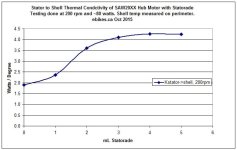
The net improvement wasn't quite as high as I'd seen on the larger DD hub motors, but it's on the order of a 40% reduction in the total Core to Ambient thermal resistance.
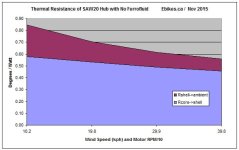
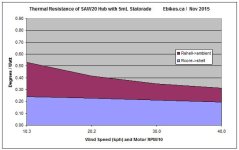
These smaller motors are much more prone to overheating even in what we consider pretty normal usage cases, so the percentage of users who would stand to benefit from Statorade is higher than with the really large (40+mm thick, >200mm dia) DD type hubs that take some serious overclocking to cook. Anyways I've added this SAW20 motor with and without the Statorade to the Trip Simulator motor database.

If you play with it there, be sure to set a 16" wheel diameter, it's definitely not a hub intended for 26" wheels.
justin_le said:That may be. BUT, the motors that stand most to gain from this for overall ebike useability are not so much massive motors but the _small_ hub motors that don't have the benefit of so much thermal mass for heat absorption.
Just to clarify this statement a little bit more on how important thermal mass can be, I've mentioned this before but now we have a tool that can illustrate with concrete results.
Let's create what would be as long and steep of a hill as any one might realistically encounter on a bike ride, with a 1000 meter elevation gain over a 6km span, with a peak grade in the middle of 20%. That's pretty much like going straight up an appreciable mountain pass. With our prototype Grin hub motor, which has low thermal mass, and no extra cooling effects, if we do the climb at a steady 30 kph then the predicted motor temperature reaches over 330 oC and we've clearly cooked the hub:

Now switch over to the large MXUS 4504 motor, and we're only 98 degrees at that same point, no worry:
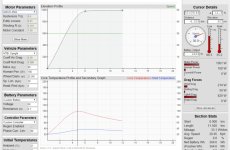
However, the MXUS motor weighs 9kg, while my original Grin hub is just 4kg. What if we were to bolt a 5kg block of aluminum to the GRIN motor core so that the weights are equal? Aluminum has a specific heat capacity of 0.9 J/gK, so that is added 4500 J/K to the motor core's heat capacity. If you click the "custom motor" option after selecting the Grin hub, and then expand the "show advanced" tab, you can see that the original heat capacity of the core was just 1200 J/K. So now we can simply edit this to be 5700 J/K to see pretty accurately how it would behave with that extra hunk of metal inside.

The net effect of is that the motor core on this mountain climb now only reaches 88 degrees celcius, that is 10 degrees COOLER than the MXUS motor without any of the benefits of additional stator width, reduced copper resistance, longer magnets etc. that the MXUS hub has.

Now if you were to keep climbing up at a 20% grade hill for many more 10's of kilometers then yes the Grin motor core would still cook and overheat, but with some rare exceptions there aren't too many bike trips that involve this kind of continuous loading.
By the same token, if you take that MXUS motor which initially seemed to perform so well on this climb, not quite hitting 100oC, and then by some great feat manage to shave it's weight in half with no change in the electrical performance characteristics, well now it reaches 160 degrees celcius at the top of this hill, and that's where you start noticing unpleasant smells coming from inside the hub

The takeaway from all this should be that even while most DIY cooling mods on ES seem to focus on large big hubs, in many cases they don't really need it since the mass itself keeps things in check. And even though we don't see too many people modding small motors for better heat dissipation, those are the ones that could use it the most.
johnrobholmes said:Now to root back through the thread for non potted mxus data to compare potted vs non potted copper temp.
Yeah, it's gotten quite cumbersome to find the actual test results scattered amongst this thread for comparison purposes, and we could benefit for sure by having an index post at the beginning that has direct links to each of the individual posts with test data. I may try to make that happen, and in the meantime will try to include the previous test data in with the new one.
On that front, lots and lots of new test data with the MXUS motors on the way, this here is what is spinning in the wind tunnel right now.
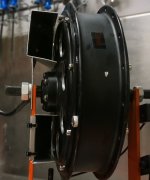
That is awesome! I always thought air scoops would be impracticable or cumbersome, but now I've seen how you've done it, I could totally see that working well.justin_le said:[On that front, lots and lots of new test data with the MXUS motors on the way, this here is what is spinning in the wind tunnel right now.
This is exactly why I went smaller (than most) and added forced air cooling to my Leaf motor for my Stealth Fighter:justin_le said:The takeaway from all this should be that even while most DIY cooling mods on ES seem to focus on large big hubs, in many cases they don't really need it since the mass itself keeps things in check. And even though we don't see too many people modding small motors for better heat dissipation, those are the ones that could use it the most.

I'll try and get some testing results this coming weekend.
Cheers
macribs
10 MW
- Joined
- Jul 22, 2014
- Messages
- 3,702
Justin, do you have access to colored smoke of any kinds to run in the wind tunnel when testing the vented side covered motor with those large scoops?
Would be awesome to see some kind of visualization of how scoop might add to the cooling.
Will you also test the vented one with FF? I wonder at what point the centrifugal forces overcome the magnetic field so that oil might start splashing around.
Any chance you could overvolt to increase RPM to see if there is any spillage?
Would be awesome to see some kind of visualization of how scoop might add to the cooling.
Will you also test the vented one with FF? I wonder at what point the centrifugal forces overcome the magnetic field so that oil might start splashing around.
Any chance you could overvolt to increase RPM to see if there is any spillage?
That's very interesting about the heat capacity. A quick look at a table of heat capacities shows water would be better than aluminum for a given mass or volume in terms of heat capacity. Iron (steel) is even better than aluminum on a volumetric basis, but heavier.
Based on that, it might make sense to have a water reservoir inside the motor. This would also tend to limit the temperature to 100C when the water starts to boil. You could have a small vent tube coming out the axle that would also allow draining/refilling. Place a whistle on the vent tube while riding for a steampunk version of overtemp alarm.
Based on that, it might make sense to have a water reservoir inside the motor. This would also tend to limit the temperature to 100C when the water starts to boil. You could have a small vent tube coming out the axle that would also allow draining/refilling. Place a whistle on the vent tube while riding for a steampunk version of overtemp alarm.
fechter said:That's very interesting about the heat capacity. A quick look at a table of heat capacities shows water would be better than aluminum for a given mass or volume in terms of heat capacity.
True, but it's structural, electrical and magnetic properties are greatly inferior
I thought water cooling a hub motor was one of the best methods to use?
Why isn't this looked at more here? It really isn't that hard to put some water blocks into the motor and make the side cover take a larger bearing for the water hoses.
Running a fuse hoses to some radiators on the bike isn't all that hard also.
Why isn't this looked at more here? It really isn't that hard to put some water blocks into the motor and make the side cover take a larger bearing for the water hoses.
Running a fuse hoses to some radiators on the bike isn't all that hard also.
macribs
10 MW
- Joined
- Jul 22, 2014
- Messages
- 3,702
Offroader said:I thought water cooling a hub motor was one of the best methods to use?
Why isn't this looked at more here? It really isn't that hard to put some water blocks into the motor and make the side cover take a larger bearing for the water hoses.
Running a fuse hoses to some radiators on the bike isn't all that hard also.
So far I think Linukas has the most experience with water cooling as he has made and sold water cooling kits for various motors, including QS and mxus I think.
But I have never seen any data published regarding heat shedding capability on his systems. Nor do I remember seeing posts made of owners of water cooled hubs comparing the heat removal before and after water cooling.
Would be sweet to see some real world data on the matter of LC hubs.
Similar threads
- Replies
- 16
- Views
- 289
- Replies
- 63
- Views
- 4,094
- Replies
- 19
- Views
- 3,268
- Replies
- 19
- Views
- 1,666

